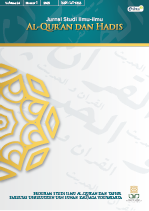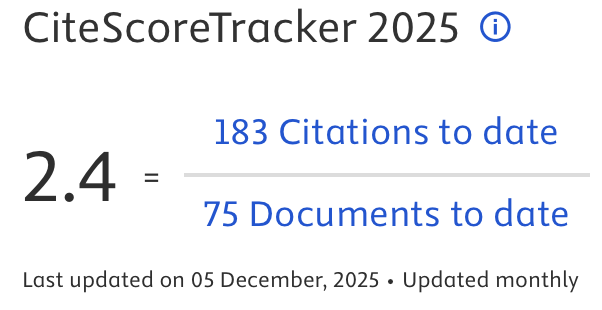The Origin of Esotericism: An Analysis of the Ismaili Esoteric Approach to Qur’anic Interpretation
DOI:
https://doi.org/10.14421/qh.v25i1.5392Keywords:
Esoteric, Ismaili, Shiite, Ismail bin Ja'far al Sadiq, Authority, TafsirAbstract
This study examines the Ismaili method of interpreting Qur’anic verses, focusing on their esoteric hermeneutics. The Quran serves as a fundamental legislative source for various theological factions, each seeking to substantiate their claims by referencing its verses. It also stands as a principal source for muhaddithin, fuqahā (jurisprudents), and others, contributing to the emergence of tafsir, a discipline aimed at elucidating the Quran's meanings and intentions. Consequently, different schools of interpretation, or tafsir, have developed over time. One strand of interpretation adheres to the literal meaning of the text, known as Zāhir, while another explores mystical or esoteric meanings, termed Bātin, occasionally without strong support from Arabic language or Qur’anic and Hadith evidence. Among Shiite sects, the Ismailis distinguish themselves as one of the most enduring, recognizing Ismail bin Ja'far al-Sādiq as their Imam and establishing influential states in Islamic history, such as the Qarmatian state in Bahrain (899–1077) and the Fatimid Caliphate in North Africa (909/1171). To thoroughly investigate this subject, a qualitative research approach is proposed. Given the historical and theological nature of the topic, qualitative methods, such as textual analysis and historical research, facilitate a comprehensive exploration and interpretation of complex phenomena. The findings of this research indicate that Ismailism has heavily relied on the esoteric interpretation of Qur’anic verses since its inception, aligning with Ismaili belief systems, with Qur’anic verses assuming a more significant role than Hadith in their doctrinal framework. The essence of this article lies in delving into the Ismaili approach to esoteric hermeneutics, predominantly drawing from the sect's primary sources.
 Abstract viewed: 687 times
|
Abstract viewed: 687 times
|
 PDF downloaded = 530 times
PDF downloaded = 530 times
References
Akkerman, Olly. A Neo-Fatimid Treasury of Books: Arabic Manuscripts among the Alawi Bohras of South Asia. Edinburgh: Edinburgh University Press, 2022.
Al-Amini, Ibrahim. Manārāt al-Hudā: Dirāsah Mawdhi'iyyah li-Mas'alah al-Imāmah wa al-Hayat. Qom: Ansarian Foundation for Printing and Publishing, 2006.
Al-Fakhr al-Rāzi. Mafātih al-Ghayb. Beirut: Dar al-Fikr, 1981.
Al-Ghazālī. Fadā'ih al-Bātiniyya. Ed. Abdul Rahman Badawi. Kuwait: Dar al-Kutub al-Thaqafiyya, n.d.
Al-Kirmānī, Hamid al-Din Ahmad. Al-Mesābih fi Ithbāt al-Imamah. Ed. Mustafa Ghaleb. Beirut: Dar al-Muntazar, 1996.
Al-Nadim. Al-Fihrist. Ed. Ayman Fuad Sayed. London: Al-Furqan Islamic Heritage Foundation, 2009.
Al-Nuʻmān. Taʼwīl al-Dʼāʼim. Ed. Muḥammad Ḥasan al-Aʻẓamī. Cairo: Dār al-Maʻārif, n.d.
Al-Qādi al-Nu'mān. Al-Majālis wa al-Musāyarāt. Ed. Al-Habib Al-Faqi, Ibrahim Shabouh, and Muhammad al-Ya'lavi. Beirut: Dar al-Muntazar Edition, 1996.
Al-Qādi al-Nu'mān. Asas al-Ta'wil. Ed. Arif Tamer, Beirut: Dar al-Thaqafa, n.d.
Al-Qādi al-Nu'mān. Taʼwīl al-Dʼāʼim. Ed. Muḥammad Ḥasan al-Aʻẓamī. Cairo: Dār al-Maʻārif, n.d.
Muhammad ibn Ya'qub al-Kulayni. al-Kāfi. Tehran: al-Maktabah al-Islamiyyah. 1963.
Al-Shahrastānī. Kitāb Al-Milal wa Al-Nihal. Cairo: Mu'assasat Al-Halabi, n.d.
Al-Shātibi. Al-Muwāfaqāt. Ed. Abu Ubaydah Mashhur ibn Hasan Al Salmān. Beirut: Dar Ibn Affan, 1997.
Al-Sijistānī. Al-Iftikhār. Ed. Ismail Poonawala. Beirut: Dar al-Gharb al-Islāmi, 2000.
Al-Sijistānī. Tuhfat al-Mustajibin: Thalāth Rasail Ismailiyya. Ed. Arif Tamer. Beirut: Dar al-Afāk al-Jadida, 1983.
Ansari, Abdul Haq. "Ḥusayn ibn Manṣūr al-Ḥallāj: Ideas of an Ecstatic." Islamic Studies 39, no. 2 (Summer 2000): 291-320.
Ansari, Abdul Haq. "Ibn 'Arabī: The Doctrine of Waḥdat al-Wujūd." Islamic Studies 38, no. 2 (Summer 1999): 149-192.
Al-Sayyid, Ayman Fuad. Al-Dawlah Al-Fāṭimīyah Tafsīr Jadīd. Cairo: Al-Hay'ah Al-ʻĀmmah lil-Kutub, 2007.
Bello, Abdulmajeed Hassan. “Islamic Law of Inheritance among the Yoruba of Southwest Nigeria: A Case Study of Dar Ul-Qadha (Arbitration Panel).” Journal of Islamic Law 5, no. 1 (February 29, 2024): 44–61. https://doi.org/10.24260/jil.v5i1.2058.
Daftary, Farhad. "Chapter 10: The Ismāʿīlīs and Their Traditions.", Handbook of Islamic Sects and Movements. 2021.
De Blois, François. "The 'Abu Saʿidis or So-Called 'Qarmatians' of Bahrain." Proceedings of the Seminar for Arabian Studies 16, Proceedings of the Nineteenth Seminar For Arabian Studies held at Oxford on 30th July - 1st August 1985 (1986): 13-21.
Dhahabī, Shams ad-Dīn. Sīyar A'lām al-Nubalā'. Ed. Bashar Awwad Ma'ruf. Beirut: Dar al-Risalah, 1985.
Dhahabī, Muhammad. Tafsir wa al-Mufassirun. Cairo: Maktabat Wahba, 1976.
Dhulkifli, Muhammad Luthfi. "To What Extent Can the Diversity of Qur’anic Tafsir Be Described as ‘Traditions of Reason’." Jurnal Studi Ilmu-Ilmu al-Qur’an dan Hadis Vol. 24, No. 1 (January 2023): 80.
Firro, Kais M. "The Druze Faith: Origin, Development and Interpretation." Arabica 58, no. 1/2 (2011): 76-99.
Ibn Jarīr ibn Yazīd al-Ṭabarī, Muḥammad. Jami' al-Bayan fi Tafsir al-Qur'an. Ed. Abdul Mohsin al-Turki. Riyadh: Dar Hajar, 2001.
Kerwanto, Kerwanto. “EPISTEMOLOGY OF THE ESOTERIC INTERPRETATION OF THE QUR’AN (Study about Ta’wīl al-Qur’ān).” Mumtaz: Jurnal Studi Al-Quran Dan Keislaman 4, no. 01 (June 30, 2020): 103–24. https://doi.org/10.36671/mumtaz.v4i01.90.
Mahmoud, Abdul Halim, Abdul Baqi Sorour. Al-Luma' fi al-Tasawwuf. Cairo: Dar al-Kutub al-Haditha, 1964.
Mahmoud, Ramy. “THE DEFINITION OF THE SUNNAH ACCORDING TO ISMAILISM: A CRITICAL READING.” Jurnal Studi Ilmu-Ilmu Al-Qur’an Dan Hadis 22, no. 1 (January 30, 2021): 185–204. https://doi.org/10.14421/qh.2021.2201-09.
Nadim, al-. Al-Fihrist. Ed. Ayman Fuad Sayed. London: Al-Furqan Islamic Heritage Foundation, 2009.
Nasr, Seyyed Hossein. Three Muslim Sages: Avicenna-Suhrawardi-Ibn Arabi. New York: Caravan Books Delmar, 1997.
Nuʻmān, Qādi. Asās al-Tā'wil. ed. Arif Tamer, Beirut: Dar al-Thaqafa, n.d.
Nuʻmān, Qādi . Taʼwīl al-Dʼāʼim. Ed. Muḥammad Ḥasan al-Aʻẓamī. Cairo: Dār al-Maʻārif, n.d.
Rāzi, Fakhr ad-Dīn. Mafāṭīḥ al-ghayb. Beirut: Dar al-Fikr, 1986.
Reynolds, Gabriel Said. "Jesus, the Qā'im and the End of the World." Rivista degli studi orientali 75, no. 1/4 (2001): 86.
Saleh, Shakib. "The Use of Bāṭinī, Fidā'ī and Ḥashīshī." Studia Islamica 82 (1995): 35-43.
Straface, Antonella. “(I) Ritual Ablution and Cultic Purity in an Ismaili Context: The Siǧistānian View.” Journal of Arabic and Islamic Studies 17 (2017): 268–79. https://doi.org/10.5617/jais.6118.
Walker, Paul. Caliph of Cairo: Al-Hakim bi-Amr Allah, 996–1021. American University in Cairo Press, 2012.
Wilcox, Andrew. "The Dual Mystical Concepts of Fanā' and Baqā' in Early Sūfism." British Journal of Middle Eastern Studies 38, no. 1 (April 2011): 95-118.
Downloads
Published
How to Cite
Issue
Section
License
Copyright (c) 2024 Ramy Mahmoud

This work is licensed under a Creative Commons Attribution-NonCommercial-NoDerivatives 4.0 International License.
Publishing your paper with Jurnal Studi Ilmu-ilmu al-Qur'an dan Hadis means that the author or authors retain the copyright in the paper. Jurnal Studi Ilmu-ilmu al-Qur'an dan Hadis uses license CC-BY-NC-ND or an equivalent license as the optimal license for the publication, distribution, use, and reuse of scholarly works. This license permits anyone to copy and redistribute the material in any medium or format and must give appropriate credit, provide a link to the license, and indicate if changes were made. If you remix, translate, transform or build upon the material you may use it for private use only and not for distribution. Jurnal Studi Ilmu-ilmu al-Qur'an dan Hadis granted an exclusive non-commercial reuse license by the author(s), but the author(s) are able to put the paper onto a website, distribute it to colleagues, give it to students, use it in your thesis, etc, so long as the use is not directed at a commercial advantage or toward private monetary gain. The author(s) can reuse the figures and tables and other information contained in their paper published by Jurnal Studi Ilmu-ilmu al-Qur'an dan Hadis in future papers or work without having to ask anyone for permission, provided that the figures, tables, or other information that is included in the new paper or work properly references the published paper as the source of the figures, tables or other information, and the new paper or work is not direct at a private monetary gain or commercial advantage.
Jurnal Studi Ilmu-ilmu al-Qur'an dan Hadis journal Open Acces articles are distrubuted under the Creative Commons Attribution-NonCommercial-NoDerivatives 4.0 International (CC BY-NC-ND 4.0). Article can be read, copy and redistribute the material ini any medium or format under the following conditions:
Attribution — You must give appropriate credit, provide a link to the license, and indicate if changes were made. You may do so in any reasonable manner, but not in any way that suggests the licensor endorses you or your use.
NonCommercial — You may not use the material for commercial purposes.
NoDerivatives — If you remix, transform, or build upon the material, you may not distribute the modified material.










